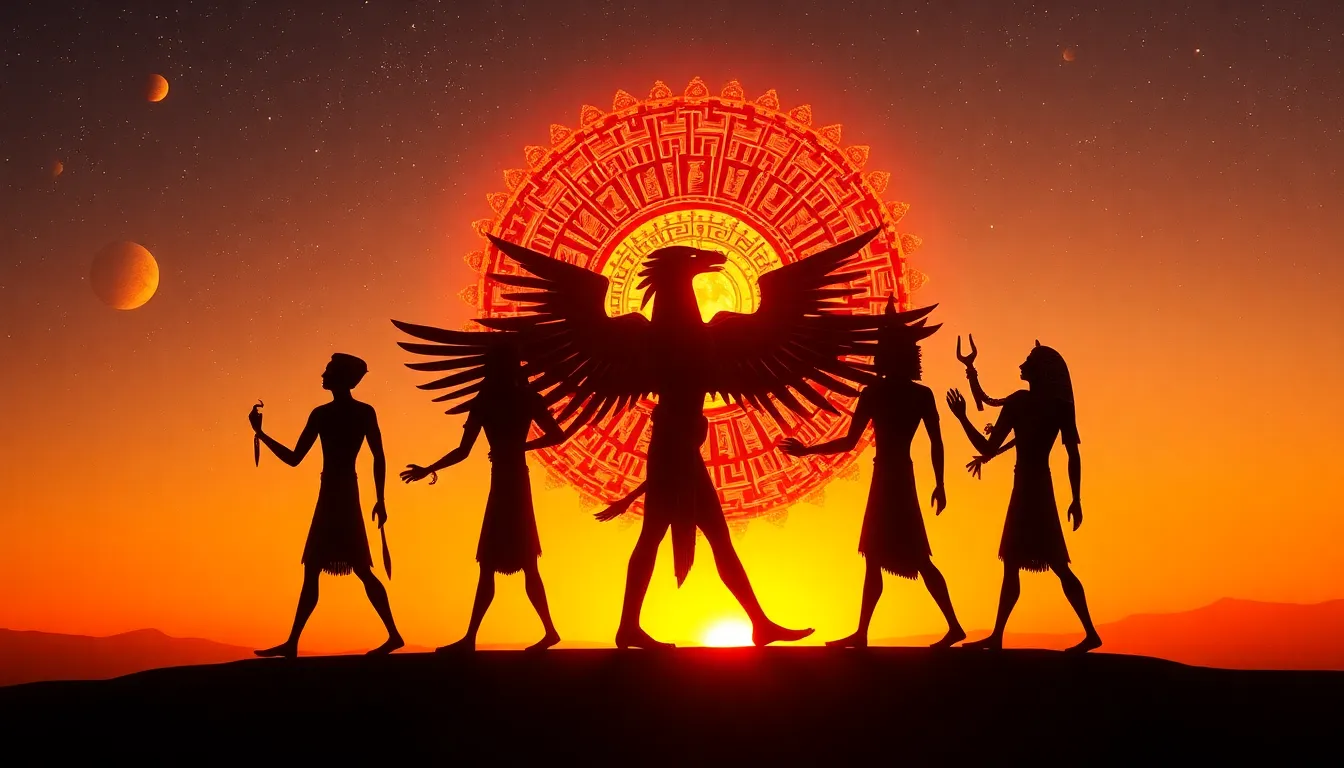The Cosmic Dance of Ra: Understanding the Sun God’s Journey
I. Introduction
In ancient Egyptian mythology, Ra, the Sun God, holds a paramount position as a deity of creation, light, and life. Revered by the Egyptians, Ra symbolizes the sun’s vital role in sustaining life on Earth. His journey across the sky was not only a daily occurrence but also a profound representation of the cosmic order and the rhythms of nature.
The significance of Ra in Egyptian culture and religion cannot be overstated. As the god who brought light and warmth, Ra was integral to the daily lives of the ancient Egyptians, influencing agriculture, timekeeping, and their spiritual beliefs. This article aims to delve into the fascinating journey of Ra, exploring its mythological origins, daily cycle, and the overarching significance of this celestial deity in Egyptian mythology.
II. The Mythological Origins of Ra
Ra’s worship dates back to the early dynastic period of Egypt, establishing him as one of the oldest deities in the Egyptian pantheon. His prominence grew as various cities adopted him as their patron god, with Heliopolis becoming a major center for his worship.
In creation myths, Ra is often depicted as the first being to emerge from the primordial waters of Nun. He created himself and subsequently birthed other gods, bringing order to chaos. The symbolism of the sun in Egyptian cosmology is profound; it represents life, growth, and the cyclical nature of existence.
III. The Daily Journey of Ra
Ra’s daily journey across the sky is a powerful symbol of life and renewal. Each day, he travels from the horizon in the east, rides high in the sky at noon, and descends into the west. This journey can be broken down into three key aspects:
- Morning: Ra rises from the waters of Nun, symbolizing rebirth and the start of a new day.
- Noon: At the zenith, Ra represents the peak of power and light, illuminating the world.
- Evening: As he sets, Ra begins his descent into the underworld, signifying the cycle of life and death.
Throughout ancient Egyptian art and literature, Ra is depicted in various forms. Common representations include a falcon-headed man adorned with a sun disk, emphasizing his divine nature and connection to the sun.
IV. Ra and the Underworld: The Nightly Voyage
At sunset, Ra embarks on a perilous journey into the underworld, known as Duat. This descent is fraught with challenges, including navigating through darkness and facing the serpent Apophis, who embodies chaos and destruction. Ra must defeat Apophis to ensure his rebirth at dawn.
The significance of Ra’s resurrection at dawn cannot be understated. This daily triumph over darkness reinforces the themes of renewal, hope, and the eternal struggle against chaos. Each sunrise represents the victory of light over darkness, a powerful metaphor for life and death in Egyptian belief.
V. Ra’s Role in the Egyptian Pantheon
Ra’s relationships with other deities are central to understanding his role in the Egyptian pantheon. He is often associated with:
- Osiris: The god of the afterlife, representing resurrection and eternal life.
- Isis: The goddess of magic and motherhood, who plays a crucial role in the myth of Osiris.
- Horus: The sky god and protector of the pharaoh, often depicted as the son of Isis and Osiris.
As Egyptian religious practices evolved, Ra became syncretized with Amun, leading to the worship of Amun-Ra. This integration showcased the adaptability of Egyptian beliefs and the merging of local and national deities into a unified worship.
VI. Ra’s Influence on Ancient Egyptian Society
Ra’s impact on ancient Egyptian society was profound and multifaceted. His influence extended to:
- Agriculture: The sun’s vital role in crop growth made Ra essential for agricultural practices.
- Timekeeping: The daily cycle of Ra helped structure the Egyptian calendar, delineating time for rituals and festivals.
- Architecture: Numerous temples and monuments, such as the Temple of Karnak, were dedicated to Ra, showcasing his importance in society.
Festivals and rituals honoring Ra often included offerings, prayers, and celebrations aimed at ensuring his favor and the continuation of the cycle of life. These practices were deeply embedded in the fabric of Egyptian culture.
VII. The Legacy of Ra in Modern Culture
Ra’s influence continues to resonate in modern culture, captivating the imagination of artists, writers, and spiritual seekers. His imagery appears in contemporary art and literature, often symbolizing enlightenment and the eternal quest for knowledge.
The enduring symbolism of the sun is also reflected in various spiritual beliefs today, where the sun remains a potent symbol of vitality and enlightenment. Ra can be compared to solar deities in other cultures, such as:
- Helios: The Greek sun god, representing light and sight.
- Surya: The Hindu sun god, embodying health and vitality.
- Sol: The Roman sun god, often associated with authority and power.
VIII. Conclusion
Ra’s journey across the sky and his nightly voyage into the underworld encapsulate the ancient Egyptian understanding of life, death, and the cosmos. His significance in Egyptian mythology reflects a deep reverence for the sun as a source of life and a symbol of eternal renewal.
As we reflect on Ra’s lasting impact, we are reminded of the profound connection between humanity and the cosmos. The stories of Ra invite further exploration into Egyptian mythology and its relevance in understanding our place in the universe today.




